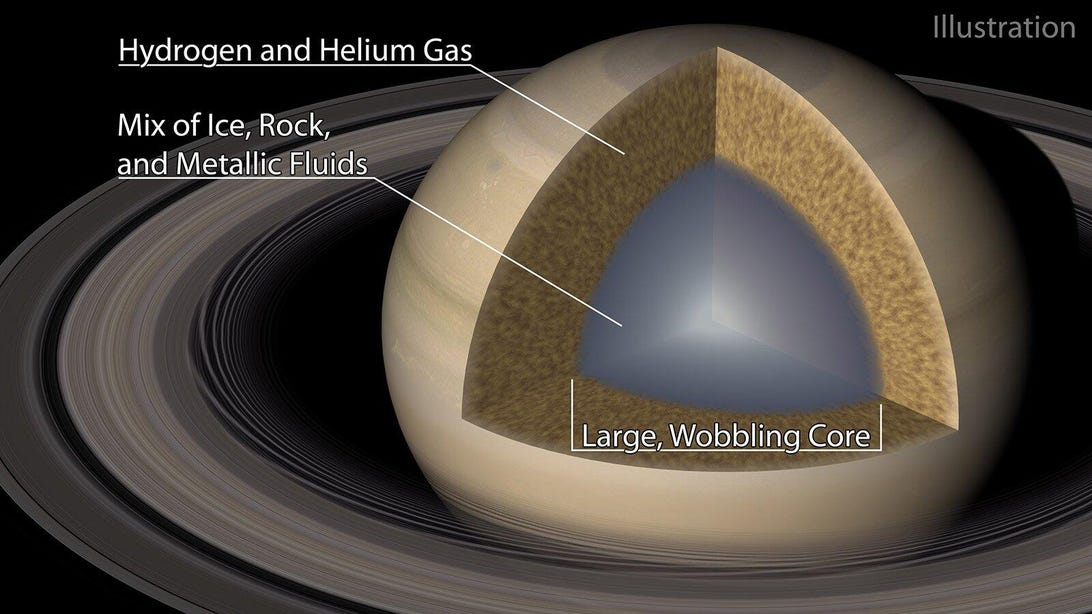
The Hubble Space Telescope took a fresh look at Saturn during its northern hemisphere summer.
NASA, ESA, A. Simon (Goddard Space Flight Center), M.H. Wong (University of California, Berkeley), and the OPAL TeamWe can't send a spacecraft into the belly of the gas giant planet Saturn (well, at least, not one that survives), so sorting out what's going on in there requires clever science work. By examining Saturn's famous rings, a team of researchers has made new discoveries about the planet's interior.
Some theories suggested Saturn's core might be a ball of rock, but a study published in the journal Nature Astronomy this week reveals what's likely "a diffuse soup of ice, rock, and metallic fluids" called a "fuzzy" core.
"The analysis also reveals that the core extends across 60% of the planet's diameter, which makes it substantially larger than previously estimated," the California Institute of Technology said in a statement on Monday.
The researchers used data from NASA's dearly departed, Saturn-studying spacecraft Cassini to make the discoveries. The team focused on ripples in the rings that are caused by a jiggling of the planet's interior. Caltech likened this concept to that of earthquakes causing our own planet to rumble.

This illustration shows Saturn and its "large, wobbling core."
Caltech/R. Hurt (IPAC)Astronomers have been aware for decades of how Saturn's jiggling might affect its rings, and the new study brings this idea into sharper focus. "We used Saturn's rings like a giant seismograph to measure oscillations inside the planet," said Caltech astrophysicist Jim Fuller, a co-author. "This is the first time we've been able to seismically probe the structure of a gas giant planet, and the results were pretty surprising."
See Saturn's secrets through NASA Cassini's finest views
See all photosSaturn might have a sloshy belly, but the team thinks it has stable layers with heavier materials in the middle. "The fuzzy cores are like a sludge. The hydrogen and helium gas in the planet gradually mix with more and more ice and rock as you move toward the planet's center," said lead author and planetary scientist Christopher Mankovich.
The Saturn findings could help us understand more about what's going on inside Jupiter, also a gas giant planet. It could also advance ideas about how gas giants form.
NASA's Cassini spacecraft plunged to its destruction in 2017 at the end of its mission, but it left us with many years worth of data on Saturn, its rings and its moons. As this new study shows, it wasn't all about the gorgeous exterior views. Cassini's journey has reached all the way to the very center of the planet.
https://news.google.com/__i/rss/rd/articles/CBMiXGh0dHBzOi8vd3d3LmNuZXQuY29tL25ld3Mvc2F0dXJuLXJpbmdzLXJldmVhbC1hLWZ1enp5LXNsb3NoeS1jb3JlLWx1cmtpbmctd2l0aGluLXRoZS1wbGFuZXQv0gFnaHR0cHM6Ly93d3cuY25ldC5jb20vZ29vZ2xlLWFtcC9uZXdzL3NhdHVybi1yaW5ncy1yZXZlYWwtYS1mdXp6eS1zbG9zaHktY29yZS1sdXJraW5nLXdpdGhpbi10aGUtcGxhbmV0Lw?oc=5
2021-08-19 17:23:00Z
CAIiENsM52iJ1zPese_O49vxOLEqEwgEKgwIACoFCAow4GowoAgwkRo
Tidak ada komentar:
Posting Komentar